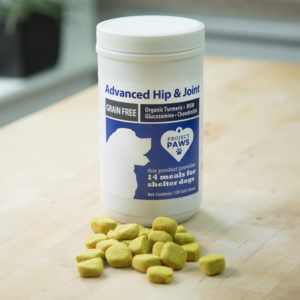Any living thing with bones and joints can get arthritis. Osteoarthritis is irritation of the joints and is a painful and common disease among dogs. I usually diagnose it in middle age to older dogs or even in younger dogs that have sustained an orthopedic injury earlier in life.
It can occur from normal wear and tear on the joints, excessive repetitive motion (like racing Greyhounds) or from an old injury. Active dogs and working dogs are certainly at risk, but any dog can suffer from this common condition. Osteoarthritis is diagnosed by physical exam findings with radiographic evidence to attempt to stage severity.
Unlike immune-mediated arthritis or infectious arthritis, osteoarthritis is classed as a non-inflammatory process, but the truth is that there is release of inflammatory chemicals (mediators) in these cases. This is supported clinically in my practice by the response to anti-inflammatory drugs.

Osteoarthritis can be managed and the goal of treatment is reducing pain and inflammation, minimizing the continued damage to the cartilage, and preserving the remaining cartilage. It is not curable or reversible at this time. My primary goal is restoring and maintaining the quality of life for OA sufferers. Many veterinarians suggest a “multi-modal” approach to pain. This means that any pain management plan should address as many parts of the pain process as is possible.
Body Weight
Not only have there been studies that prove that normal weight dogs live longer than their overweight counterparts*, also reducing body weight will reduce the pressure placed on his/her joints. You pet should have a waist when viewed from the side and above and you should be able to feel his ribs when you press on his sides. If you find that you have to press really hard or you have to use your imagination to know where the ribs are, he is too big. This is a difficult issue and we all know that we feel terrible to deny our friends, but if we know that it will help him to live longer and better, it is easier. Ask your vet to give you advice on how much your dog should be fed.

Exercise
People think that arthritis sufferers should not exercise, but we have found the opposite to be true. Low impact exercise like walking or swimming can help build up the muscle strength to divide the load on the joints. I tell all my clients to get their dogs moving and outside if possible. It is great for the pets and the people. Your dog will have a better sleep cycle, better behavior and it will enhance your bond in so many ways to get out together every day. Physical therapy is another form of exercise that has restored quality of life for many of my patients. You want to choose a licensed veterinary therapist, but this safe addition to the protocols can be a life saver. The only limitations here are cost and convenience.
Non-prescription supplements
Disease Modifying therapies include things like glucosamine, chondroitin and many others. These agents are aimed at preserving the integrity of the cartilage and slowing the damage to it. Different dogs will respond differently to these agents, but they are usually safe and sometimes effective. They may be worth adding into your dog’s protocol. Be advised that these agents are not FDA regulated, so you want to be sure to choose the products that your vet specifically recommends, as there is no regulation on quality or proof of efficacy. Let your veterinarian guide you to the products that he/she has seen success with in our patients. These types of supplements are commonly reported for accidental ingestion to Poison Control centers, so be sure they are stored out of reach. They are designed to be a supplemental therapy and will not be as effective if given alone, but in many cases, I am able to reduce the amount of other medications that I need to restore quality of life with these.

Non-steroidal anti-inflammatories
In my patients, non-steroidal anti-inflammatories are often effective. There are many options and response is individual. The goal is to find the lowest effective dose by using other therapies in conjunction with them. They are not without their side effects and tend to be costly. These drugs are prescription only and do require a veterinarian relationship. There are other medications that can also be added to address other parts of the “pain cascade” and your veterinarian is the best resource for trying things that may provide the right “recipe” for your dog.
If your dog seems to feel stiff or slow these days or you notice actual lameness, osteoarthritis might be the culprit. Just because the condition is incurable does not mean that we are powerless against it, and the symptoms can be managed and reduced. Addressing the ailments often seen in aging pets can help insure that his golden years are truly the best time of his life.
*See “Effects of Diet Restriction on Life Span and Age-Related Changes in Dogs,” Journal of the American Veterinary Medical Association, May 1, 2002.
